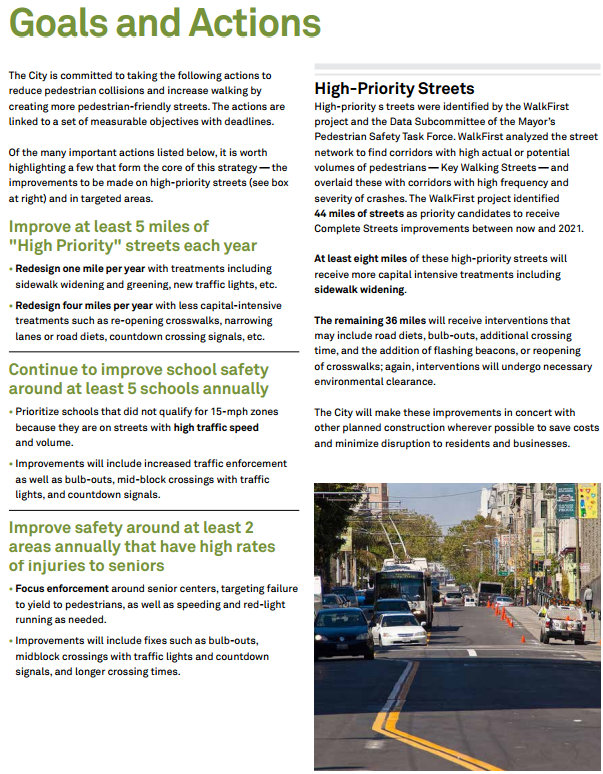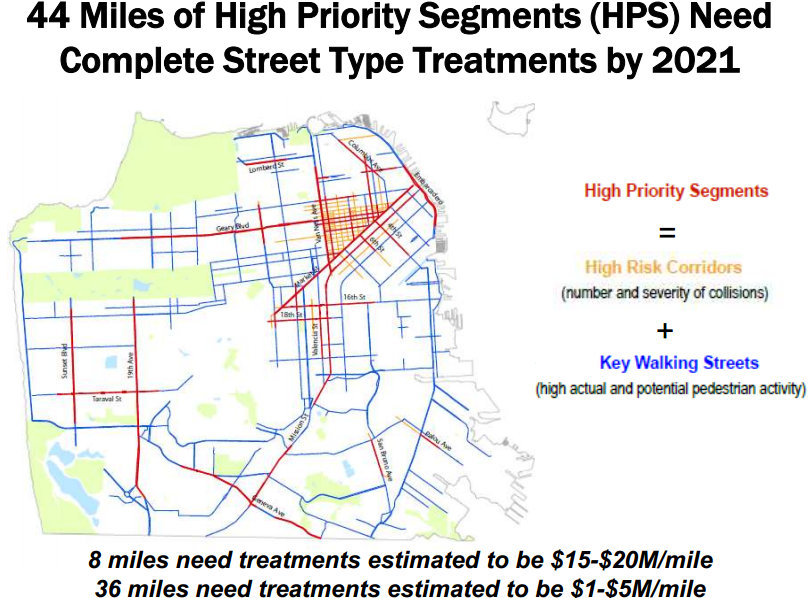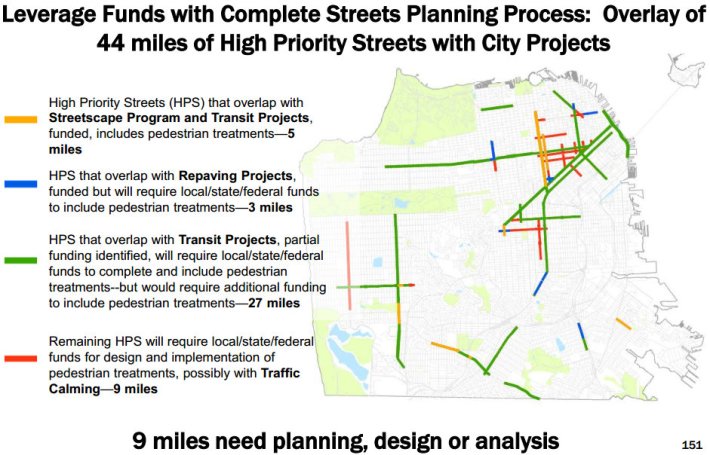Two years after the Pedestrian Safety Task Force formed to devise a plan to meet the ambitious targets for reducing injuries set by former Mayor Gavin Newsom, the SF Municipal Transportation Agency has released its Draft Pedestrian Strategy [PDF]. The document serves as a rough guide for how the city can re-engineer streets and target traffic enforcement to make walking safer in the coming years.
Advocates say the goals are on par with the targets set forth by cities like Chicago and New York, who have recently set the bar with their own pedestrian safety plans. But implementing the infrastructure called for in the plan will require leadership from Mayor Ed Lee and other elected officials, who must increase the abysmal level of funding dedicated to pedestrian safety projects, as well as a diligent effort by city agencies to get the most out of their budgets by integrating pedestrian improvements into transit and road re-paving projects.
"We're very pleased with the central ambitious commitment set out in the Pedestrian Strategy: to fix five miles of streets per year," said Walk SF Executive Director Elizabeth Stampe, who praised the plan for taking "a big step forward with clear metrics and timelines. With these, it creates accountability. Walk SF and its members will be monitoring the implementation of the plan closely."
"The mayor's goal is to cut injuries in half," added Stampe. "To succeed will take political will and funding. The SFMTA's Strategic Plan states that 'infrastructure support for walking is cost-effective,' but over and over again [at the SFMTA board meeting this week] we heard how little we're spending on pedestrian improvements."

As Streetsblog has reported, two to three pedestrians are injured in San Francisco every day. In addition to the human toll, this costs the city an estimated $76 million per year, much of that in health care costs paid for out of public funds. Two pedestrians have been killed in January alone. Last year, 19 pedestrians died in traffic, and 17 were killed in 2011. Overall, roughly 800 to 900 pedestrians are hit by cars in the city every year.
"When comparing ourselves to other major U.S. cities, many look towards San Francisco as being on the leading edge of progressive transportation," said Paul Supawanich, a transportation planner at Nelson/Nygaard and former chair of the SF Pedestrian Safety Advisory Committee. "However, in the arena of pedestrian safety, places like New York and Chicago were setting the standard, we were behind. While it's taken longer to produce than many had expected, the Pedestrian Safety Task Force has produced a great vision, and one that provides meaningful and tangible steps towards reducing pedestrian injuries and fatalities."
To meet the targets set in former Mayor Gavin Newsom’s Executive Directive on Pedestrian Safety -- a 25 percent reduction in injuries by 2016, and 50 percent by 2020 -- the Pedestrian Strategy calls for a range of efforts, including substantial pedestrian infrastructure improvements on five miles of "high priority" streets per year, which are defined as "key walking steets" where the most frequent and severe injuries occur. Overall, the Pedestrian Strategy identifies 44 miles of high-priority streets in need of improvement by 2021.
Of those five annual miles, one mile is to be improved with infrastructure investments estimated at $15 to $20 million per mile, including treatments like sidewalk widenings, greening and new traffic lights. The other four miles are to include "less capital-intensive treatments such as re-opening crosswalks, narrowing lanes or road diets," and countdown crossing signals, at a cost of $1 to $5 million per mile.
Other goals within that timeframe include re-opening 20 closed crosswalks, adding pedestrian countdown signals at 184 intersections, increasing signalized crossing time at 800 intersections, upgrading 13,000 curb ramps over ten years, and creating one new plaza and 20 parklets annually. The Pedestrian Strategy also calls for data-driven traffic enforcement that targets the most dangerous violations on the most dangerous corridors (the SFPD recently dubbed the new strategy “Focus on the Five"). Schools and senior centers would also be prioritized for street improvements and enforcement.
To implement the Pedestrian Strategy, the SFMTA estimates it would need an additional $33 million each year, more than double the amount expected to be available for pedestrian improvements. Given the abysmal state of dedicated funding for pedestrian safety, the strategy identifies 35 high-priority pedestrian streets where transit, road re-paving, and other projects could potentially be used to leverage funding by including pedestrian upgrades in the projects.
"This is the least-funded mode we have in terms of our dedicated funding sources," said Tim Papandreou, deputy director of transportation planning for the SFMTA's Sustainable Streets Divison. "If we thought transit was woefully inadequate in funding, there's virtually no categories at the federal, state, and local level that are adequate to fund pedestrian improvements."
"We take walking for granted," he added.
Stampe pointed out that "projects for better walking are just over 1 percent of SFMTA's capital budget."
"That's a ridiculously small amount, when about 20 percent of trips are entirely made by walking, and 35 percent involve significant walking," she said. "Ultimately, every trip begins and ends with walking, as we heard multiple times from the agency [at the board meeting]. Funding needs to increase, to better reflect the fact that pedestrian improvements benefit everyone -- 100 percent of San Francisco's residents and workers."
Few potential funding streams have been named, but SFMTA officials said the agency could put a general obligation bond on the ballot to fund the bicycle, pedestrian, and transit improvements called for in the agency’s broader Strategic Plan, though no dollar amounts have been identified. Revenue could also come from an increase in the vehicle license fee if the Board of Supervisors puts it on the ballot in November, as well as new funding streams once the Transportation Sustainability Program is adopted.
While San Francisco's elected officials have paid much lip service to improving bicycling in the city (though they've take little action to fund it), they haven't been as keen to take leadership on pedestrian safety. Jane Kim, supervisor of District 6, which sees nearly 30 percent of the city's pedestrian injuries, has called hearings on the issue and pushed the SFMTA to speed up the pace of improvements. D8 Supervisor Scott Wiener and recently-inaugurated D7 Supervisor Norman Yee have also brought pedestrian safety into the discourse at board meetings.
Yet Mayor Lee, who told Streetsblog soon after his inauguration in 2011 that "I am a big fan of [Mayor Newsom's] executive directive and I am definitely wanting to lower, if not eliminate, pedestrian fatalities,” has only seemed to occasionally stand behind pedestrian efforts when signs of progress arise. Last month, he touted the Pedestrian Strategy last month before he could offer details on it. This week, Lee's hour-long "State of the City" speech included only one passing sentence mentioning the issue.
Without leadership from city officials to bring a dramatic increase in resources devoted to preventing deaths and life-altering crashes suffered by San Franciscans, the Pedestrian Strategy will remain an unrealized vision.
"Every time I see that another pedestrian has lost their life on our streets, it breaks my heart, especially to think that it could've been prevented easily," said Joél Ramos, a member of the SFMTA Board of Directors. "I can't imagine the horror the families are feeling when that happens... and we can do things about that. Tomorrow, we could say we're going to bring the speed limit down to 20 miles per hour in the whole city, and that's going to change things dramatically."







